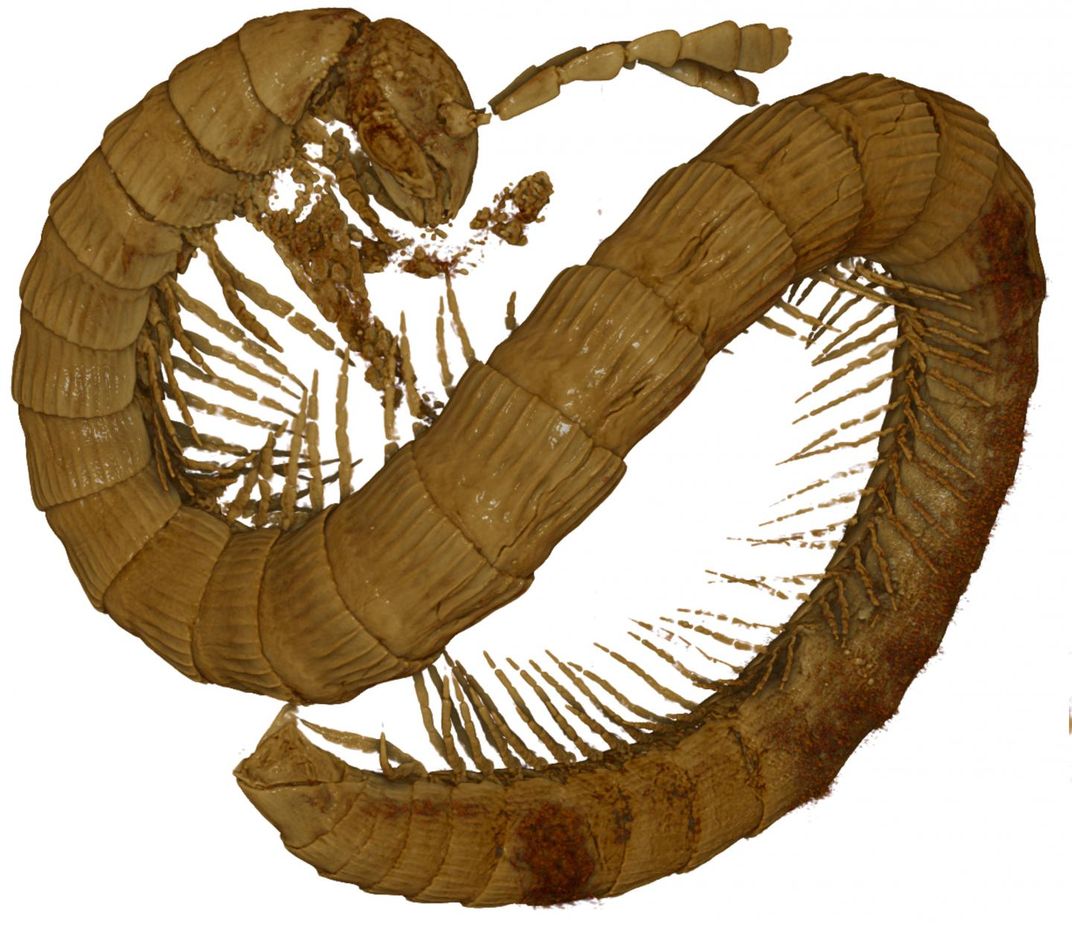This Petite, 99-Million-Year-Old Millipede Was Entrapped in Amber
The diminutive arthropod represents not only a previously unknown species, but an entirely separate Callipodida suborder
/https://tf-cmsv2-smithsonianmag-media.s3.amazonaws.com/filer/57/60/576075c5-8c49-4e44-8672-dab7c167064c/199319_web.jpg)
About 99 million years ago, a petite millipede unlike any known today found itself entrapped in viscous tree resin that eventually hardened into Burmese amber. Newly dubbed Burmanopetalum inexpectatum, the arthropod measured just 8.2 millimeters, boasted five-unit compound eyes, and had an unusually hairless hypoproct—or in layman's terms, butt. The critter was a far cry from modern millipedes, which can reach up to 100 millimeters in length and have at least 30 optical units.
As a trio of researchers report in the journal ZooKeys, a new analysis of the singular specimen suggests it represents not only a previously unknown species, but an entirely separate Callipodida suborder. Thanks to the animal’s advanced state of preservation, lead author Pavel Stoev of Bulgaria’s National Museum of Natural History tells Newsweek’s Aristos Georgiou, the team now has “sound evidence” that the Callipodida lineage—formerly absent from the fossil record—emerged at least 99 million years ago, undergoing significant evolutionary changes over the intervening millennia.
Stoev and colleagues Leif Moritz and Thomas Wesener of Germany’s Zoological Research Museum Alexander Koenig used micro-computed X-ray tomography, or micro-CT, scans to create a 3-D model of the millipede. According to Atlas Obscura’s Sabrina Imbler, the digital rendering captured the arthropod’s skeleton, internal anatomy and characteristic horde of tiny legs. As Live Science’s Mindy Weisberger notes, the scans further showed that the creature, forever frozen in a curled-up “S” shape, had 35 body rings and fully developed sperm-storing sacs indicative of its status as an adult female.
The ancient millipede, which roamed the forests of Myanmar when dinosaurs ruled the Earth, is of note more for its morphology than its method of preservation. In fact, Becky Ferreira writes for Vice, the specimen is just one of more than 529 amber-entrapped millipedes owned by Patrick Müller, a German collector who allowed Stoev, Moritz and Wesener to inspect around 400 of his amber fossils.

Several factors differentiate B. inexpectatum—whose name stems from the Latin word for “unexpected”—from the rest of these millipede specimens: It’s the only member of the Callipodida order present in Müller’s collection and, most significantly, is decidedly diminutive.
“Next to its modern relatives, … it would be considered a dwarf,” Stoev tells Newsweek’s Georgiou, adding that the same could be said in comparison with the millipede’s predecessors, which include the comparatively giant Arthropleura millipedes of North America and Scotland. Active between 229 million and 315 million years ago, these arthropods measured up to 230 centimeters, or 7.5 feet, in length.
“The species is peculiar in having a specially shaped last segment, which would have played a role in its biology,” Stoev explains. “Surprisingly, it also lacks characteristic hair-like outgrowths on the back, which are present in all extant members of the order Callipodida. Another unusual feature is its very simple eyes, whereas most of its modern peers have complex vision.”
Compared to some of the more lively scenes captured in amber fossils—think a spider attacking a wasp, an ant beleaguered by a parasitic mite and even a lizard seemingly suspended in mid-air, or rather mid-amber—the millipede appears to be almost at peace. Much like the headline-making insect found entombed in opal earlier this year, it offers a visually appealing, contemplative glimpse into the distant past.
“It came as a great surprise to us that this animal [could not] be placed in the current millipede classification,” Stoev concludes in a press release. “Even though their general appearance have remained unchanged in the last 100 million years, as our planet underwent dramatic changes several times in this period, some morphological traits in Callipodida lineage have evolved significantly.”
/https://tf-cmsv2-smithsonianmag-media.s3.amazonaws.com/accounts/headshot/mellon.png)
/https://tf-cmsv2-smithsonianmag-media.s3.amazonaws.com/accounts/headshot/mellon.png)